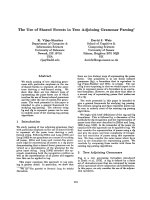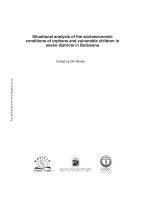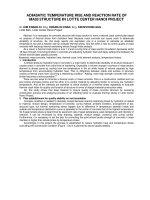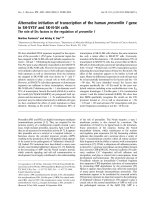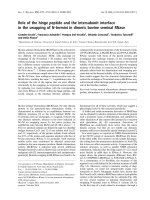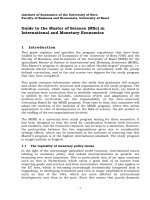Socio-economic Conditions of Women Workers in Plantation Industry 2008‐09 pptx
Bạn đang xem bản rút gọn của tài liệu. Xem và tải ngay bản đầy đủ của tài liệu tại đây (253.26 KB, 86 trang )
Socio-economic
Conditions of Women
Workers in Plantation
Industry
2008‐09
Government of India
Ministry of Labour & Employment
Labour Bureau
Chandigarh
Reji
PREFACE
Since ancient times, women in India are making financial
contribution for the betterment of their families.
Their participation in
economic activities of the country has grown enormously after rapid
industrialization in post independence era.
Increased participation of
women in economic activities on one hand has helped them to narrow
down the gap between their needs and resources, while on the other hand
it has given rise to a number of complex problems having a direct bearing
on their Socio-economic Conditions.
To solve the problems faced by the women workers engaged in
various industries, a sound planning based on accurate and reliable data
bank is needed. Accordingly, the present scheme titled “Socio-economic
Conditions of Women Workers in Industry” was taken up by the Bureau,
during the year 1975 – “The International Women’s Year”. Initially, the
scheme was confined to the organised sector only. However, keeping in
view the utility of the data so generated, it was considered to extend the
scope of scheme to the Un-organised Sector as well. A beginning was
made by covering Building and Construction industry followed by
Handloom,
Khadi,
Beedi,
Readymade
Garments,
Agarbathi,
Lime
Manufacturing, Cashewnut Processing and Food processing Industry
(including Sea Food and Marine Products). The present report relates to
the Plantation Sector.
I
am
thankful
to
the
various
departments
of
the
Central
Government, and the States, especially the States Labour Departments,
for their whole hearted Co-operation in the conduct of the study. I also
extend my thanks to all the employers and workers of the sampled units
who
willingly
furnished
detailed
information
for
the
study.
I would like to place on record my appreciation for the dedicated
efforts put in by the team of officers and staff members of the SESDSL
section of Labour Bureau for conducting the survey and bringing out this
report.
Views, if any, expressed in this report are not necessarily those of
the
Ministry
of
Labour
and
Employment,
Government
of
India.
Suggestions for the improvement of such surveys are welcome.
(K.S.R.V.S. Chalam)
Director General
Chandigarh
Dated: 20/07/2009
Contents
Executive Summary
i-v
I
Introduction
1-7
II
Sampling Design
8-13
III
General Characteristics of
Plantation Industry
14-22
IV
Working Conditions
23-39
V
Wages and Earnings
40-45
VI
Social Security Benefits
46-56
VII
Living Conditions
57-67
Case Study I
68-71
Case Study II
72-75
Case Study III
76-78
ANNEXURE I - TABLES
ANNEXURE II – Questionnaires
Executive Summary
To assess the socio economic condition of women labour in
Plantation Industry the survey is conducted in six states
where plantations are grown. Field work was undertaken
during the period September – October, 2008.
The survey is conducted in 4 plantations viz. tea, coffee,
rubber and cardamom.
A total of 132 unit level and 827 worker level schedules are
canvassed during the survey.
More than 50 per cent of the total workers employed in the
plantations are women workers.
In non-manual jobs majority of the workers are male.
Majority of the workers are un-skilled and employed as
plantation labourers.
Most of the units surveyed are found paying annual bonus to
their workers.
Majority of the units are allowing weekly off without wages to
the workers.
A few cases of sexual harassment 3.0 per cent are reported
during the last two years.
About 60 per cent of units have put in place the mechanism
to redress the grievances of workers.
Around 63 per cent of the units surveyed are member of
Employers’ Association.
i
Among manual workers Plantation Labourers constitute
majority. Their average per day earnings work out to be Rs
67.6 at aggregate level.
Only 48.5 per cent of the units are providing medical facilities
to workers and their family members.
In Karnataka state very few units are found providing
medical facilities to workers.
Crèche facility is provided by only 37.1 per cent of the total
units surveyed.
In coffee, rubber and cardamom plantations very few units
are providing crèche facility.
In coffee and cardamom, no unit is found providing education
facility to the children of its workers.
Housing facility is provided by 77.3 per cent of the total units
surveyed.
Housing facility to workers is provided by maximum units
(97.9 per cent) in tea plantations and minimum units (50.0
per cent) in cardamom units.
Maternity benefits are provided by 73.5 per cent of the total
units surveyed.
Among the cardamom plantation units, only 38.9 per cent are
providing maternity benefit to their women workers.
Only 17.4 per cent of the total units surveyed have appointed
welfare officers.
In coffee and cardamom units no welfare officers is found
appointed.
ii
Concessional items are found to be provided only in the tea
plantation units.
At aggregate level, 23.5 per cent of the
units are providing various types of concession to the
workers.
Canteen facility is provided by only 12.9 per cent of the units
surveyed.
In Assam state, from which maximum number of sample
units are drawn, and which employs majority of the
plantation workers, only 16.7 per cent units are providing
canteen facility.
The basic welfare amenities like urinals and latrines are
provided by only 9.8 per cent of the units surveyed.
Rest shelter is provided by 25.0 per cent of the units
surveyed.
A separate welfare facilities for women workers like washing
facility, separate urinals, rest shelter are provided by 6.1 per
cent, 7.6 per cent and 6.8 per cent and unit respectively.
More than five percent of the plantation workers are
migrated from other states.
Average family size of the sampled women workers is 4.2
members at overall level.
Majority of the sampled women workers (54.4 percent) are
found to be illiterate.
Average number of earners per women worker house hold is
found to be two members.
Very meager i.e. 1.1 per cent, women workers are found to be
working beyond the normal daily hours of work.
iii
A very few i.e. 5.3 per cent women workers are provided
educational facility by the employer.
Around 59 per cent of the women workers have membership
of a trade union
Only 34.7 percent, 18.5 per cent and 43.5 per cent women
workers are aware of Minimum Wage Act, 1948, Equal
Remuneration Act, 1976 and Maternity benefits Act, 1961.
About 42 per cent of the women workers are saving money.
iv
CHAPTER – I
INTRODUCTION
1.1
Agriculture has been the oldest form of activity practiced by people
in the civilized world. Though many of the developed countries have
moved away from agriculture to industrialization as their main stay
of economic activity, there is no ruling out of agriculture as part of
the basic economic activity in any part of the world. There are still
certain
parts
of
globe,
where
agriculture
is
predominantly
influential in determining well being of the people.
1.2
India is also such a country, where about 70 per cent of the labour
force is employed in the agriculture sector. Although in the recent
years the share of agriculture in Gross Domestic Product is coming
down, still agriculture is the dominant sector of the economy and it
impacts the well being of the other sectors. Plantation is a part of
agriculture and it directly employs more than 2 million workers in
the country. Plantation plays a very crucial role in the export of
agricultural produce. About 15 per cent of the total export earnings
of agriculture products come from crops like tea, coffee and rubber,
although these plantations occupy only one per cent of the total
cropped area.
1.3
Plantations are economic entities connected historically with certain
crops. A plantation crop normally is a monoculture and includes
growing of variety of products like Tea, Coffee, Rubber, Pepper &
other spices etc.
1.4
The cultivation of crops is taken-up in areas which are conducive to
their growth and is mainly determined by the consideration of
rainfall, altitude where estates are situated and availability of
1
labour. It is seen that the traditional areas of plantation crops are
undergoing a change and newer and newer areas are taking to
growing plantation crops. The main reason for such an expansion is
the growth in markets, both domestic and foreign.
1.5
The main feature of plantations in India is their structural
concentration in terms of their size. The bulk production of tea (80
per cent) is accounted by the corporate sector or by large estates,
whereas the bulk production in rubber (87 per cent) and coffee (60
per cent) comes from the small holdings.
1.6
A majority of the workers in the plantation sector are women. The
reason for this is that these plantations are historically linked with
colonialism. The plantations are located in remote areas and were
sparsely populated during the colonial period. As a result, families
were employed rather than individuals, thus absorbing women in
the labour force. This work force does not possess any skills other
than plucking leaf and the workers are mostly landless.
1.7
In the overall economic activity in India, women workers constitute
about one-fifth of the total work force, out of which only six per cent
are employed in the organized sector. Rest of the women workers
are engaged in the unorganized sector. In spite of the mandatory
legislative protective provisions, the extent of their exploitation
exists not only in unorganized sector but in the organized sector
also. Due to
unsatisfactory implementation of protective legislative
provisions concerning women workers, there still remains a
yawning gap between these provisions and the facilities actually
made available to them. There are still cases where women workers
are deprived of the benefits and amenities like equal remuneration
vis-à-vis their male counterparts, maternity benefits, proper child
care services, etc. Several factors responsible for their plight are,
indifferent attitude of the employers towards women workers, their
2
weak bargaining power and in many cases the women workers
themselves being unaware of their rights. Although the Government
is seized of the situation, yet it continues to remain a problem area
due to non-availability of reliable statistical data and other
information pertaining to working, living and socio-economic
conditions of women workers.
1.8
It has been a constant endeavor on the part of the Labour Bureau,
Ministry of Labour & Employment, for providing reliable data on
women workers employed both in organized and un-organized
sectors and projecting a realistic picture aimed at enabling the
Government to take ameliorative measures for the benefit of women.
1.9
The first enquiry for studying socio-economic conditions of women
workers was undertaken by Labour Bureau in the year 1953 and a
report titled “The Economic and Social Status of Women Workers in
India” was brought out. The enquiry was conducted through mailquestionnaire method and was confined to important industries in
the country employing women in large numbers, viz. Cotton and
Jute Textiles, Coal Mines and Plantations. Later on, the Labour
Bureau and Planning Commission jointly prepared a study in 1958
titled “Women in Employment 1901 – 1956”. There after the Labour
Bureau brought out a few reports on the basis of available
published/unpublished
data.
One
such
report
“Women
in
Employment” was brought out in the year 1964 and another
publication “Women in Industry” in the International Women’s Year
(1975) presented an objective assessment of the trend of women’s
employment, their wages and earnings and laws and regulations
governing their employment and working conditions.
1.10 In the year 1975, a full fledged scheme namely “Socio-Economic
Conditions of Women Workers” was entrusted to Labour Bureau
3
with the objective of assessing the working and living conditions of
women workers employed in organized industries where they are
significantly employed. In the earlier years, the scope of the survey
was restricted to organized industries only where predominantly
women workers were employed. However, in view of the importance
of this labour force and also the dominant existence of unorganized
sector in the Indian economy, where more than 90 per cent of the
labour force is engaged in the unorganized sector/employment, the
scope of the survey was extended to organized sector also. The first
survey under the scheme was conducted in Mines sector in the year
1976-77.
So far Labour Bureau has conducted 22 surveys on
“Socio-Economic Conditions of Women Workers” including the
present survey. The list of surveys conducted so far is at Annexure-I
1.11 Women workers have all along been an integral part of the labour
force engaged in the Plantation Industry in India. A majority of the
plantations labourers are women workers. Owing to the very fact
that soft hands and nimble fingers are suited especially for tea leave
plucking and picking of coffee seeds, women workers dominate the
employment scene in these Plantations.
1.12 Significant contribution to the Indian economy by way of exports
notwithstanding, the wages of workers in the plantation sector
especially the women workers continue to remain low. The
ineffective implementation of the statutory provisions has impeded
the progress in the direction of alleviating the plight of women
workers in this industry. Paucity of reliable data and other
information have been the major drawbacks. In order to assess the
ground reality in this regard, a survey on “Socio-Economic
Conditions of Women Workers in Plantations” was conducted by the
Labour Bureau during the period from September -October, 2008.
The objective of the survey is to bring to the fore the actual working
and living conditions of women workers.
4
1.13 Tea plantation provides employment to more than a million workers
who comprise immigrant workers and their descendents. For
example, the workers in the tea gardens of Tamil Nadu are not
original residents of the region but are migrants from Karnataka
and other nearby states. The labourers of Assam and West Bengal
are people who migrated from Central India and Nepal. These
workers have over the years settled down in the gardens and now
have little or no contact with their place of origin.
1.14 India is one of the leading producer of tea in the world. The country
produces both ‘CTC’ (“Cut, tear & Curl”) and ‘Orthodox’ types of tea.
The most commonly tea consumed in India is CTC. About 27 per
cent of the world’s tea is produced in India. India is also the world’s
largest consumer of tea. About 22 per cent of the world’s
consumption is in India. Tea production is both land as well as
labour intensive activity.
1.15 Tea Plantations are predominantly located in hills and interior areas
of North-Eastern and Southern states of India. Assam, West Bengal,
Tamil Nadu and Kerala are the major tea producing states.
Karnataka, Tripura, Himachal Pradesh, Uttrakhand, Arunachal
Pradesh, Manipur, Sikkim, Nagaland, Meghalaya, Mizoram, Bihar
and Orissa are the other states where tea is also grown but to a
small extent. Tea is grown from the plains to an elevation of nearly
2500 meters, spread over different climatic zones, which enables
India to produce different types of tea.
1.16 The Plantation sector has been instrumental in developing the
under developed regions of the country. As mentioned earlier, the
bulk of coffee and natural rubber in the country is produced by
small holdings. Some of the world’s fine varieties of coffee, namely,
Arabices and Robustes are grown in India on high elevations in
geographically unique areas like Anamalis (Tamil Nadu), Araku
5
Valley (Andhra Pradesh), Nelliompathys and Wayanaad (Kerala). A
wide variety of spices and fruit crops like vanilla, orange and
banana grow alongside coffee plants.
1.17 India contributes about 4.5 per cent of the world production of
coffee and it is pre-dominantly produced in Karnataka, Kerala and
Tamil Nadu. The share of Karnataka, Kerala and Tamil Nadu is 70.7
per cent, 21.3 per cent and 6.9 per cent respectively, whereas the
share of other regions is about 1.0 per cent. Due to its labour
intensive nature, it is an important source of rural employment for
men and women, especially in parts of South India.
1.18 Rubber plays an important role in the industrial and economic
development of the country. Rubber plantations provide the
principal raw material required for manufacture of around 35,000
rubber products ranging from toy balloons to tyres of giant earth
moving equipments. India is the fourth largest consumer of natural
rubber.
1.19 Rubber is primarily grown in the states of Kerala and adjoining
Kanya-kumari district of Tamil Nadu, which are the traditional
rubber growing areas of the country. Both areas are geographically
and agro-climatically suitable for rubber cultivation. Besides this,
rubber is also grown in Tripura, Assam, Meghalaya, Mizoram, etc.
1.20 Rubber plantations are spread over 5.78 lakh hectares in 16 states
of the country. The production of rubber is dominated by small
holdings, which account for 91 per cent of the total production and
88 per cent of the area with an average holding size of 0.5 hectare.
There are nearly 0.7 million people engaged in this rubber
plantations as workforce either directly or indirectly.
6
1.21 Cardamom, the queen of all the spices, has a history as old as
human race. It is dried fruit of an herbaceous perennial plant.
Country’s warm humid climate, loamy soil rich in organic matter,
distributed rain fall and special cultivation and processing abilities
make India’s cardamom unique in aroma, flavor, size and colour,
which is parrot green.
1.22 Cultivation of cardamom is mostly concentrated in the ever green
forest of Western Ghats in South India. Kerala, Karnataka and
Tamil Nadu are the main producers of cardamom. These states
contribute more than 90 per cent to the total production of
cardamom in India.
7
CHAPTER – II
SAMPLING
DESIGN
Scope and Coverage
2.1
The scope of the survey is restricted to tea, coffee, rubber and
cardamom plantations. All the major plantation growing states were
asked to provide a list of tea, coffee, rubber, cinchona and
cardamom
plantations.
However,
due
to
non-availability
of
exhaustive list of Cinchona plantation could not be covered.
2.2
The survey was conducted in all the major plantation growing
states. For tea plantations the states of Assam, Tamil Nadu, West
Bengal, Kerala, and Tripura have been covered. In case of coffee,
Tamil Nadu, Kerala and Karnataka have been taken. The units
under
the
rubber
plantations
are
covered
in
Tamil
Nadu,
Karnataka, Kerala and Tripura and under the cardamom plantation
these are covered from Tamil Nadu and Kerala.
Sampling Design
2.3
A two stage sampling design was adopted for the survey. In the first
stage of sampling, the sample size of unit level or employer level
schedules has been determined. Further from the selected first
stage sampling units, worker level schedules have been canvassed
as second stage sample.
2.4
The sample size of the unit level schedules has been determined in
such a way that the estimates do not differ from the true values by
more than 5 per cent with confidence co-efficient 95 per cent.
8
2.5
The first stage sample size is determined on the basis of the
Co-efficient of variance of the average maximum wage rates revealed
by the sixth round of Occupational Wage Survey done in Plantation
Industry (2005). Accordingly, the sample size of Tea, Coffee and
Rubber has been taken as 44 units, 32 units and 30 units
respectively.
2.6
The sample size in occupational wage survey report of ‘Plantation
Industry’ (2005) is available only for tea, coffee and rubber
plantations. The sample size of these three plantations taken
together is about 3.5 per cent of the total units in the frame.
However, for cardamom plantation, a sample size of 17 units is
taken, which is about 15.5 per cent of the total number of units in
the cardamom plantation’s frame.
2.7
The total number of units in each plantation has been further
divided into two size classes, viz. Upper Size Class and Lower Size
Class. The size class in any plantation is determined on the basis of
average employment in the industry. The average employment is
calculated as, total number of workers in the particular plantation
divided by total number of units in that particular plantation. The
sample has been allocated to a size class in proportion to the
number of units in that size class to the total units in the frame.
Further, it is taken care that at least two units are selected from
each size class in a stratum. The total number of units in the frame
and the sample selected from upper and lower size class is
presented in Table 2.1.
9
Table 2.1
Number of Units in the Frame and Sample Selected Therein
Sl.
No.
Stratum
No. of Units
in the
Frame
Stratum-I
Upper Size
Class
743
274
177
67
76
1337
10
2
4
2
0
18
14
8
2
2
3
29
294
941
139
1374
2
5
2
9
6
17
2
25
19
97
140
26
2
2
0
5
2
0
2
10
10
2
0
284
9
24
6
104
110
3105
0
3
3
39
2
13
15
93
Tea
1
2
3
4
5
Plantations
Assam
Tamil Nadu
West Bengal
Kerala
Residual
Total
Coffee Plantations
1 Tamil Nadu
2 Karnataka
3 Kerala
Total
Rubber Plantations
1 Tamil Nadu
2 Karnataka
3 Kerala
4 Tripura
5 Andaman & Nicobar
Island
Total
Cardamom Plantations
1 Tamil Nadu
2 Kerala
Total
ALL PLANTATIONS
2.8
Stratum-II
Lower Size
Class
Further, the workers level schedules are canvassed from the units
selected in the first stage. The worker level schedules are canvassed
only for women workers in each selected unit. The actual number of
women workers covered depends upon the women employment in
the sample units as under:
10
Table 2.2
Number of Workers Schedules to be Canvassed
Sl.
No.
1
2
3
4
Sl.
No.
1
2
Sl.
No.
1
2
TEA PLANTATION
No. of Women Workers Schedules to
Size of Women Employment
be Canvassed
Minimum
Maximum
Women Employment ( 1 to 50 )
2
10% of Women Emp. or 5
Women Employment ( 51 to 150 )
6
06% of Women Emp. or 9
Women Employment (151 to 300 )
10
04% of Women Emp. or 12
Women Employment ( 301 and above )
13
02% of Women Emp. or 15
COFFEE PLANTATION
No. of Women Workers Schedules to be
Size of Women Employment
Canvassed
Minimum
Maximum
Women Employment ( 1 to 15 )
3
30% of Women Emp. or 5
Women Employment ( 16 and above )
6
20% of Women Emp. or 10
RUBBER PLANTATION
No. of Women Workers Schedules to be
Size of Women Employment
Canvassed
Minimum
Maximum
Women Employment ( 1 to 50 )
3
20% of Women Emp. or 10
Women Employment ( 51 and above )
11
15% of Women Emp. or 15
CARDAMOM
Sl.
No.
1
2
PLANTATION
No. of Women Workers Schedules to be
Size of Women Employment
Canvassed
Minimum
Maximum
Women Employment ( 1 to 13 )
3
30% of Women Emp. or 4
Women Employment ( 14 and above )
5
20% of Women Emp. or 10
Objective of the survey
2.9
The main objective of the study is to collect socio-economic data of
women workers in the plantation industry with a view to studying
the problems faced by them in their working, living and social
conditions and the extent of welfare amenities available to them viza-viz the various labour laws.
11
Definitions
2.10 Plantation : The term ‘Plantation’ has been defined under the
Plantation Labour Act, 1951 to include any plantation to which the
Act, whether wholly or in parts, applies and includes offices,
hospitals, dispensaries, schools and other premises used for any
purpose connected with such plantation. Section 1(4) of the Act
applies to any land used or intends to be used for growing tea,
coffee, rubber, cinchona and cardamom which measures 5 hectare
or more and in which fifteen or more persons are employed or were
employed on any day of the preceding twelve months.
2.11 Worker : Worker means a person (including any member of the
medical staff) employed in a plantation for hired or reward, whether
directly or through any agency, to do any work, skilled, unskilled,
manual or clerical but does not include :i)
A medical officer employed in the plantation.
ii)
Any person employed in the plantation primarily in a
managerial capacity or
iii)
Any person temporarily employed in the plantation in any
work
relating
to
the
construction,
development
or
maintaince of buildings, road, bridge or canals.
2.12 Employer: when used in relation to a plantation, it means the
person who has the ultimate control over the affairs of the
plantation and where the affairs of any plantation are entrusted to
any other person (whether called a managing agent, manager,
superintendent or by any other name) such person shall be deemed
to be the employer in relation to that plantation.
12
2.13 Family : when used in relation to a worker, means
i)
his or her spouse and
ii)
the
legitimate
and
adopted
children
of
the
worker
dependent upon him or her, who have not completed their
eighteenth year and includes , where the worker is a male,
his parents dependent upon him.
Questionnaire Canvassed
2.14 Two specially designed schedules were canvassed for the purpose of
this survey. The unit level questionnaire was canvassed to capture
the working condition of workers employed in the four plantations.
A unit level questionnaire was designed to collect data for the unit
as a whole on important parameters like, year of establishment,
type of ownership, mode of employment, mode of pay period, wages
and earnings of the manual workers, leave and holidays, daily
hours of work, sex-wise employment of workers in the plantation,
trade unions, welfare amenities available to workers, social security
benefits, etc.
2.15 The worker level schedule is designed to collect the data on living
conditions of women workers employed in the plantation. The
schedule was designed to capture the important aspects like
migration status, caste, demographic particulars (age profile,
marital status, educational qualification etc.), wages & earnings,
total
household
income
&
savings,
indebtedness,
medical
expenditure, etc.
2.16 The survey was launched in the first week of September, 2008 and
was completed by third week of October, 2008.
13
CHAPTER – III
GENERAL CHARACTERISTICS OF
PLANTATION INDUSTRY
3.1
The Plantation sector has been instrumental in developing the
under-developed areas of the country. Tea is cultivated in remote,
hilly regions and coffee is an integral part of the ecology of the
Western Ghats. While the bulk production of coffee, natural rubber
and spices comes from small holdings, bulk of tea is produced by
large estates owned by corporate sector. General characteristics of
Plantation Industry are discussed in the forthcoming paragraphs of
this chapter.
3.2
Plantation is a unique sector, where most of the establishments are
known to be century old. To know the years, since the sample units
is working, the establishment year of the unit is collected in the
survey. It may be seen from Table 3.1 that, more than 50 per cent
of the tea units are established before the year 1950. However, for
rubber and cardamom, the results reveal that more than 60 per
cent of the units are established after the year 1970. At aggregate
level 25.0 per cent of the plantations are found established before
the year 1950, followed by 15.2 per cent between the year 1950-60
and 13.6 per cent each in the year between 1960-70 and 1970-80.
The details of establishment of the sampled units are presented in
Table 3.1.
3.3
Information is also collected on the ownership type of the
plantation. Generally the plantation may be owned privately,
publicly, by a co-operative, or jointly. The results show that a
majority of the sampled units are privately owned (82.6 per cent),
followed by 16.7 per cent publicly owned and only 0.8 per cent by
14
some
co-operative
society.
In
Kerala
sampled
units
of
all
plantations, except 13.3 units in rubber plantations, are found
owned privately. However, all the units under rubber plantations in
Karnataka and Tripura are publicly owned. At aggregate level, 54.5
per cent of the rubber sampled units are publicly owned. The cooperative units are observed only among the tea plantations of
Assam state. About 4.2 per cent of the sampled tea units in Assam
state are run through co-operative society.
The details of
distribution of the units by ownership type are presented in Table
3.2.
3.4
As discussed in the introductory chapter, majority of the plantation
labourers are women workers. In tea Plantations, the highest share
of women workers (61.5 per cent) is in Kerala, followed by 57.3 per
cent in Tamil Nadu and 57.1 per cent in West Bengal. In all the
sampled units of tea plantations, 53.0 per cent workers are women.
In coffee and cardamom plantations, the trend is similar and the
women workers are reported to be 55.2 per cent and 56.9 per cent
respectively at aggregate level. The maximum proportion of women
workers in coffee units is observed in Tamil Nadu (59.2 per cent)
followed by Kerala (57.5 per cent) and Karnataka (53.0 per cent).
However, in rubber plantations only 39.9 per cent women workers
are reported to be employed in the units surveyed. In rubber
plantations, the main work is collecting latex from the rubber trees
and it is mainly done by the male workers. In Tripura, only 18.7 per
cent female workers are reported which are the minimum as
compared to all other plantations. Taking all plantations together,
51.2 per cent of the reported workers are female. The distribution of
male and female workers plantation- wise and the share of women
workers in total workers are presented in Table 3.3.
3.5
Table 3.3 shows that the sample units of the four plantations viz.
tea, coffee, rubber and cardamom are located mainly in six states,
15
namely, Assam, Tamil Nadu, West Bengal, Kerala, Karnataka and
Tripura. A total of 132 plantation units, comprising 47 units of tea
(35.6 per cent), 34 units of coffee (25.8 per cent), 33 units of rubber
(25 per cent) and 18 units (13.6 per cent) of cardamom plantation
are selected for the study. The work in plantations industry is
predominantly of manual type. Therefore information of manual
and non-manual workers in the sampled units is collected
separately during the survey. The non-manual jobs include Medical
Officers, Teachers, Managers, Welfare Officer and clerical staff. On
the other hand, in the manual category of workers, Field
Supervisors, Plantation Labourers, Field Workers, Rubber Tappers,
Watchmen are included. The survey results reveal that majority of
the workers are engaged in manual jobs. In tea plantations, 95.1
per cent of the workers are doing manual jobs as Plantation Labour,
Field Workers, Supervisor etc. The proportion of male, female and
adolescents are 45.0 per cent, 54.3 per cent and 0.7 respectively in
tea plantations. In coffee plantations the trend is similar and 90.9
per cent of the workers are doing manual jobs. Further, the
proportion of male, female and adolescents in coffee are 39.0 per
cent, 60.0 per cent and 1.0 per cent respectively. At aggregate level,
the manual workers are about 95 per cent. No child worker is found
employed in any of the plantation surveyed.
3.6
In tea plantation, 4.9 per cent workers are found employed in the
non-manual category. Majority of the non-manual jobs are being
done by male workers. In tea plantation, 82.3 per cent employment
in non-manual jobs is of male workers. Similar trends on women’s
participation in non-manual jobs are found in other plantations. In
coffee units 9.1 per cent of the total workers are employed in nonmanual jobs and the share of male and female workers in nonmanual jobs is 94.2 per cent and 5.8 per cent respectively. In case
of cardamom plantation all the non-manual jobs are done by the
male workers. At aggregate level 83.6 per cent and 16.4 per cent are
16
male and female workers respectively in non-manual jobs. No child
and adolescent are found employed in any of the non-manual jobs
in all the sampled units surveyed. The sex-wise details of the
manual and non-manual workers are presented in Table 3.3.
3.7
The Plantation Labour Act, 1951 suggests that medical, housing
and educational facilities etc. are to be provided by the employer to
the workers employed in the plantation. Accordingly, during the
survey, the information on the non-manual jobs linked to above
stated activities is also collected. The percentage distribution of
non-manual workers occupation-wise like Manager, Medical Officer,
teaching staff, clerical and other workers is presented in Table 3.5.
As discussed earlier, there are only 5.6 per cent non-manual
workers employed in the sampled units at aggregate level. Further,
in absolute terms there are 1,106 male workers and 217 female
workers employed in non-manual jobs. The survey results reveal
that majority of the male workers i.e. 32.1 per cent at aggregate
level engaged in non-manual jobs are employed in clerical jobs,
followed by 23.1 per cent in managerial and 11.3 per cent in
medical profession. In teaching occupation only 4.0 per cent of the
male workers are found employed. In the sampled units of coffee
plantations, the trend is different, as 72.9 per cent of the nonmanual male workers are found employed in managerial jobs. No
male worker in the units of coffee and cardamom plantation is
found working in the teaching occupation indicating that teaching
facility to workers is not provided by these plantations.
3.8
The female workers at aggregate level in the non-manual job
categories are mostly employed in medical occupations (55.3 per
cent), followed by teaching (18.0 per cent) and clerical jobs (6.9 per
cent). In the tea plantation units, 62.4 per cent of female workers
are employed in medical jobs followed by 13.5 per cent in teaching
and 4.1 per cent in managerial jobs. In coffee plantation units no
17
